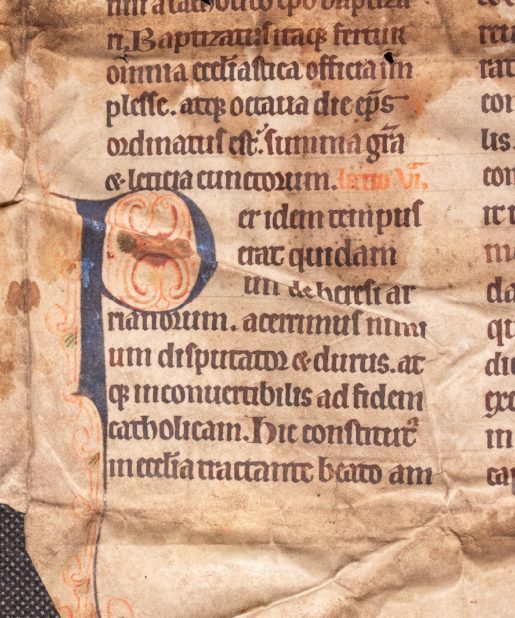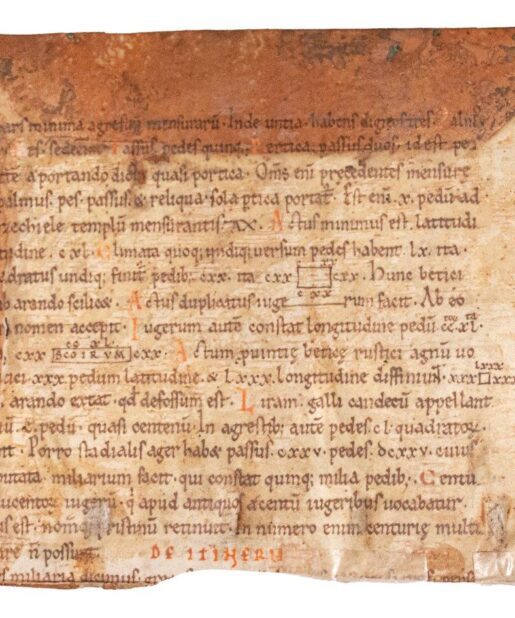Cuttings from a Romanesque copy of Priscian Institutiones Grammaticae, in Latin with a single word in Greek, manuscript on parchment. [Germany, 12th century].
£3,800.00
Cuttings from a Romanesque copy of Priscian Institutiones Grammaticae, in Latin with a single word in Greek, manuscript on parchment. [Germany, 12th century].
4 rectangular cuttings (all half leaves bisected laterally), largest 165 x 125mm, with remnants of single column of 18 lines in a handsome Romanesque script, capitals touched or dotted in red, rubrics in capitals underlined in red simple red initials (some with baubles mounted in their bodies) remains of a red line-drawn cat in the margin (standing on its hind legs to form an initial ‘I’), tiny marginalia, some scuffs, stains and folds, the smaller 2 pieces cockled, one particularly so, overall fair and legible condition.
Priscian (more properly Priscianus Caesariensis) lived in the opening of the 6th century AD during the final collapse of the Roman Empire. He was a native of Caesarea in North Africa and was educated and taught in Constantinople. This text was one of the fundamental textbooks of the mediaeval West for those wishing to learn Latin and no monastery, cathedral or secular school could be without a copy. Thus some 527 extant manuscripts are recorded today (M. Gibson in Scriptorium 26, 1972 and some 283 of those in existence by the 12th century). For modern scholarship the text is a storehouse of classical Roman works such as Plautus and Cicero (named on these cuttings) as well as a few lost works.
Be the first to review “Cuttings from a Romanesque copy of Priscian Institutiones Grammaticae, in Latin with a single word in Greek, manuscript on parchment. [Germany, 12th century].” Cancel reply
Product Enquiry
Related products
C12th - C13th manuscripts
Miniature Breviary leaf with unusual and handsome script, c.1280
C12th - C13th manuscripts
Huge C12th bifolium of St Augustine’s Tractate 94 on St. John’s gospel.
C12th - C13th manuscripts
One of the earliest Latin manuscripts of Hippocrates c.1175, France – the Prognostics 2 leaves.
C12th - C13th manuscripts
Elegant English Early Gothic Script from late C12th Passionale – Paulinus of Milan
C12th - C13th manuscripts
C12th - C13th manuscripts

![Cuttings from a Romanesque copy of Priscian Institutiones Grammaticae, in Latin with a single word in Greek, manuscript on parchment. [Germany, 12th century]. Cuttings from a Romanesque copy of Priscian Institutiones Grammaticae, in Latin with a single word in Greek, manuscript on parchment. [Germany, 12th century].](https://butlerrarebooks.co.uk/wp-content/uploads/2023/05/IMG_9986-scaled.jpg)
![Cuttings from a Romanesque copy of Priscian Institutiones Grammaticae, in Latin with a single word in Greek, manuscript on parchment. [Germany, 12th century]. Cuttings from a Romanesque copy of Priscian Institutiones Grammaticae, in Latin with a single word in Greek, manuscript on parchment. [Germany, 12th century].](https://butlerrarebooks.co.uk/wp-content/uploads/2023/05/IMG_9981-scaled.jpg)
![Cuttings from a Romanesque copy of Priscian Institutiones Grammaticae, in Latin with a single word in Greek, manuscript on parchment. [Germany, 12th century]. Cuttings from a Romanesque copy of Priscian Institutiones Grammaticae, in Latin with a single word in Greek, manuscript on parchment. [Germany, 12th century].](https://butlerrarebooks.co.uk/wp-content/uploads/2023/05/IMG_9982-2-scaled.jpg)
![Cuttings from a Romanesque copy of Priscian Institutiones Grammaticae, in Latin with a single word in Greek, manuscript on parchment. [Germany, 12th century]. Cuttings from a Romanesque copy of Priscian Institutiones Grammaticae, in Latin with a single word in Greek, manuscript on parchment. [Germany, 12th century].](https://butlerrarebooks.co.uk/wp-content/uploads/2023/05/IMG_9983-scaled.jpg)
![Cuttings from a Romanesque copy of Priscian Institutiones Grammaticae, in Latin with a single word in Greek, manuscript on parchment. [Germany, 12th century]. Cuttings from a Romanesque copy of Priscian Institutiones Grammaticae, in Latin with a single word in Greek, manuscript on parchment. [Germany, 12th century].](https://butlerrarebooks.co.uk/wp-content/uploads/2023/05/IMG_9984-2-scaled.jpg)
![Cuttings from a Romanesque copy of Priscian Institutiones Grammaticae, in Latin with a single word in Greek, manuscript on parchment. [Germany, 12th century]. Cuttings from a Romanesque copy of Priscian Institutiones Grammaticae, in Latin with a single word in Greek, manuscript on parchment. [Germany, 12th century].](https://butlerrarebooks.co.uk/wp-content/uploads/2023/05/IMG_9985-3-scaled.jpg)






![Cuttings from a Romanesque copy of Priscian Institutiones Grammaticae, in Latin with a single word in Greek, manuscript on parchment. [Germany, 12th century]. Cuttings from a Romanesque copy of Priscian Institutiones Grammaticae, in Latin with a single word in Greek, manuscript on parchment. [Germany, 12th century].](https://butlerrarebooks.co.uk/wp-content/uploads/2023/05/IMG_9289-scaled-100x100.jpg)
![Cuttings from a Romanesque copy of Priscian Institutiones Grammaticae, in Latin with a single word in Greek, manuscript on parchment. [Germany, 12th century]. Cuttings from a Romanesque copy of Priscian Institutiones Grammaticae, in Latin with a single word in Greek, manuscript on parchment. [Germany, 12th century].](https://butlerrarebooks.co.uk/wp-content/uploads/2023/05/IMG_9973-scaled-100x100.jpg)







![Pontifical, service book for use by a bishop, in Latin [France, mid- to third quarter of the twelfth century] Pontifical, service book for use by a bishop, in Latin [France, mid- to third quarter of the twelfth century]](https://butlerrarebooks.co.uk/wp-content/uploads/2024/09/IMG_0290-515x618.jpg)
![The Model for 15th-Century Humanistic Script and Decoration – A large bifolium from a decorated Lectionary, in Latin [Italy, 12th century, first half] The Model for 15th-Century Humanistic Script and Decoration – A large bifolium from a decorated Lectionary, in Latin [Italy, 12th century, first half]](https://butlerrarebooks.co.uk/wp-content/uploads/2021/04/IMG_0688-515x618.jpg)
![The Model for 15th-Century Humanistic Script and Decoration – A large bifolium from a decorated Lectionary, in Latin [Italy, 12th century, first half] The Model for 15th-Century Humanistic Script and Decoration – A large bifolium from a decorated Lectionary, in Latin [Italy, 12th century, first half]](https://butlerrarebooks.co.uk/wp-content/uploads/2021/04/IMG_0686-515x618.jpg)
![A very large fragmentary leaf from a Lectionary, in Latin, decorated manuscript on vellum [Germany (Rhineland?), 12th century (first half)] A very large fragmentary leaf from a Lectionary, in Latin, decorated manuscript on vellum [Germany (Rhineland?), 12th century (first half)]](https://butlerrarebooks.co.uk/wp-content/uploads/2024/09/IMG_1184-515x618.jpg)
![A very large fragmentary leaf from a Lectionary, in Latin, decorated manuscript on vellum [Germany (Rhineland?), 12th century (first half)] A very large fragmentary leaf from a Lectionary, in Latin, decorated manuscript on vellum [Germany (Rhineland?), 12th century (first half)]](https://butlerrarebooks.co.uk/wp-content/uploads/2024/09/IMG_1183-515x618.jpg)


Reviews
There are no reviews yet.